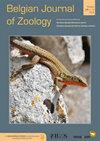Microniphargus属(甲壳纲,两栖纲):分布在欧洲西北部的三个谱系的证据,以及从Niphargidae转移到Pseudoniphargida的证据
IF 1.1
4区 生物学
Q2 ZOOLOGY
引用次数: 7
摘要
在比利时收集的样本中首次描述了微裂孔蝇(Microniphargus leruthi Schellenberg, 1934)(片足目:裂孔蝇科),并将其归入裂孔蝇科的单型属。然而,其形态的一些细节以及最近的系统发育研究表明,微虹鳟可能与伪虹鳟(amphi足纲:伪虹鳟科)的亲缘关系比与Niphargus的亲缘关系更密切。此外,从爱尔兰到德国,M. leruthi的活动范围超过1 469公里,这是令人吃惊的,因为只有少数niphargids证实活动范围超过200公里。为了确定M. leruthi的系统发育位置,并检查其是否可能是一个隐种复合体,我们收集了来自爱尔兰、英国和比利时的材料,并对线粒体细胞色素c氧化酶亚基1基因片段和核28S核糖体基因片段进行了测序。两种标记的系统发育分析表明,微食蚜蝇更接近于伪食蚜蝇而非食蚜蝇,从而将微食蚜蝇重新归入伪食蚜蝇科。我们还确定了三个相同的有丝分裂核谱系分别存在于爱尔兰,比利时和英格兰,以及仅在英格兰(后者在一个地点的同属中发现),这表明M. leruthi是至少三个物种的复合体,假定的起源中心在英格兰。本文章由计算机程序翻译,如有差异,请以英文原文为准。
The genus Microniphargus (Crustacea, Amphipoda): evidence for three lineages distributed across northwestern Europe and transfer from Niphargidae to Pseudoniphargidae
Microniphargus leruthi Schellenberg, 1934 (Amphipoda: Niphargidae) was first described based on samples collected in Belgium and placed in a monotypic genus within the family Niphargidae. However, some details of its morphology as well as recent phylogenetic studies suggest that Microniphargus may be more closely related to Pseudoniphargus (Amphipoda: Pseudoniphargidae) than to Niphargus. Moreover, M. leruthi ranges over 1,469 km from Ireland to Germany, which is striking since only a few niphargids have confirmed ranges in excess of 200 km. To find out the phylogenetic position of M. leruthi and check whether it may be a complex of cryptic species, we collected material from Ireland, England and Belgium then sequenced fragments of the mitochondrial cytochrome c oxidase subunit 1 gene as well as of the nuclear 28S ribosomal gene. Phylogenetic analyses of both markers confirm that Microniphargus is closer to Pseudoniphargus than to Niphargus, leading us to reallocate Microniphargus to Pseudoniphargidae. We also identify three congruent mito-nuclear lineages present respectively in Ireland, in both Belgium and England, and in England only (with the latter found in sympatry at one location), suggesting that M. leruthi is a complex of at least three species with a putative centre of origin in England.
求助全文
通过发布文献求助,成功后即可免费获取论文全文。
去求助
来源期刊

Belgian Journal of Zoology
生物-动物学
CiteScore
1.90
自引率
0.00%
发文量
10
审稿时长
>12 weeks
期刊介绍:
The Belgian Journal of Zoology is an open access journal publishing high-quality research papers in English that are original, of broad interest and hypothesis-driven. Manuscripts on all aspects of zoology are considered, including anatomy, behaviour, developmental biology, ecology, evolution, genetics, genomics and physiology. Manuscripts on veterinary topics are outside of the journal’s scope. The Belgian Journal of Zoology also welcomes reviews, especially from complex or poorly understood research fields in zoology. The Belgian Journal of Zoology does no longer publish purely taxonomic papers. Surveys and reports on novel or invasive animal species for Belgium are considered only if sufficient new biological or biogeographic information is included.
 求助内容:
求助内容: 应助结果提醒方式:
应助结果提醒方式:


